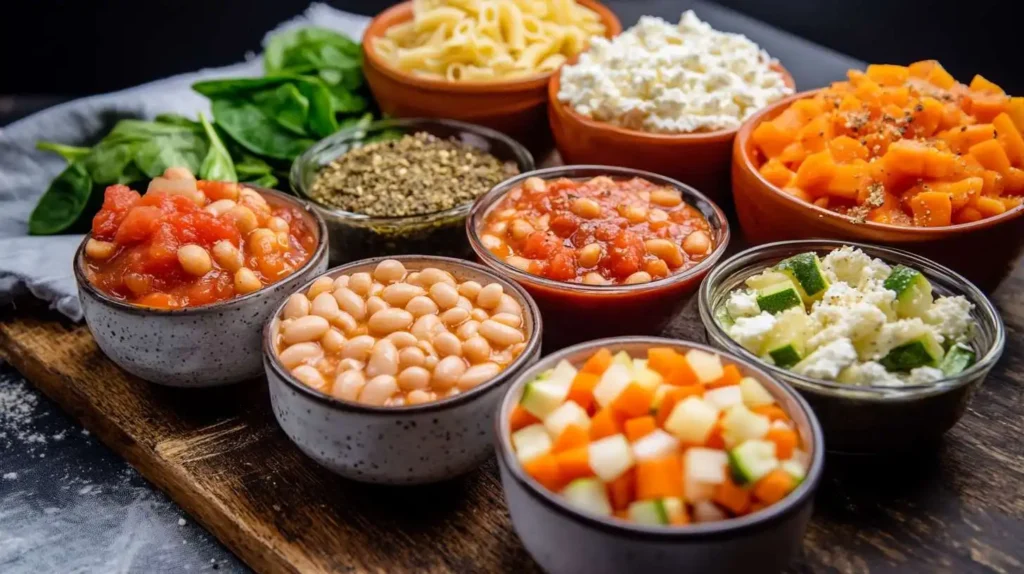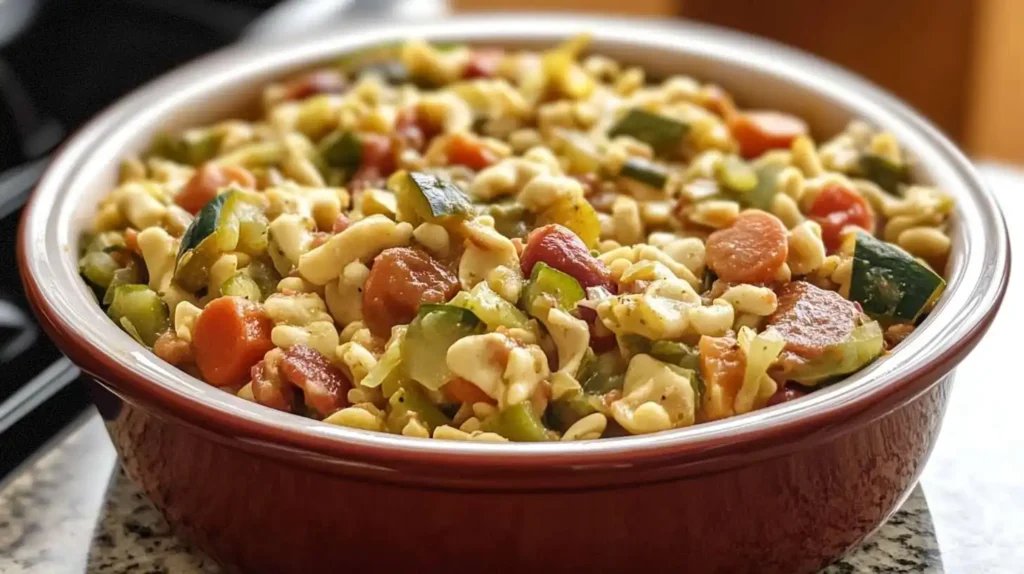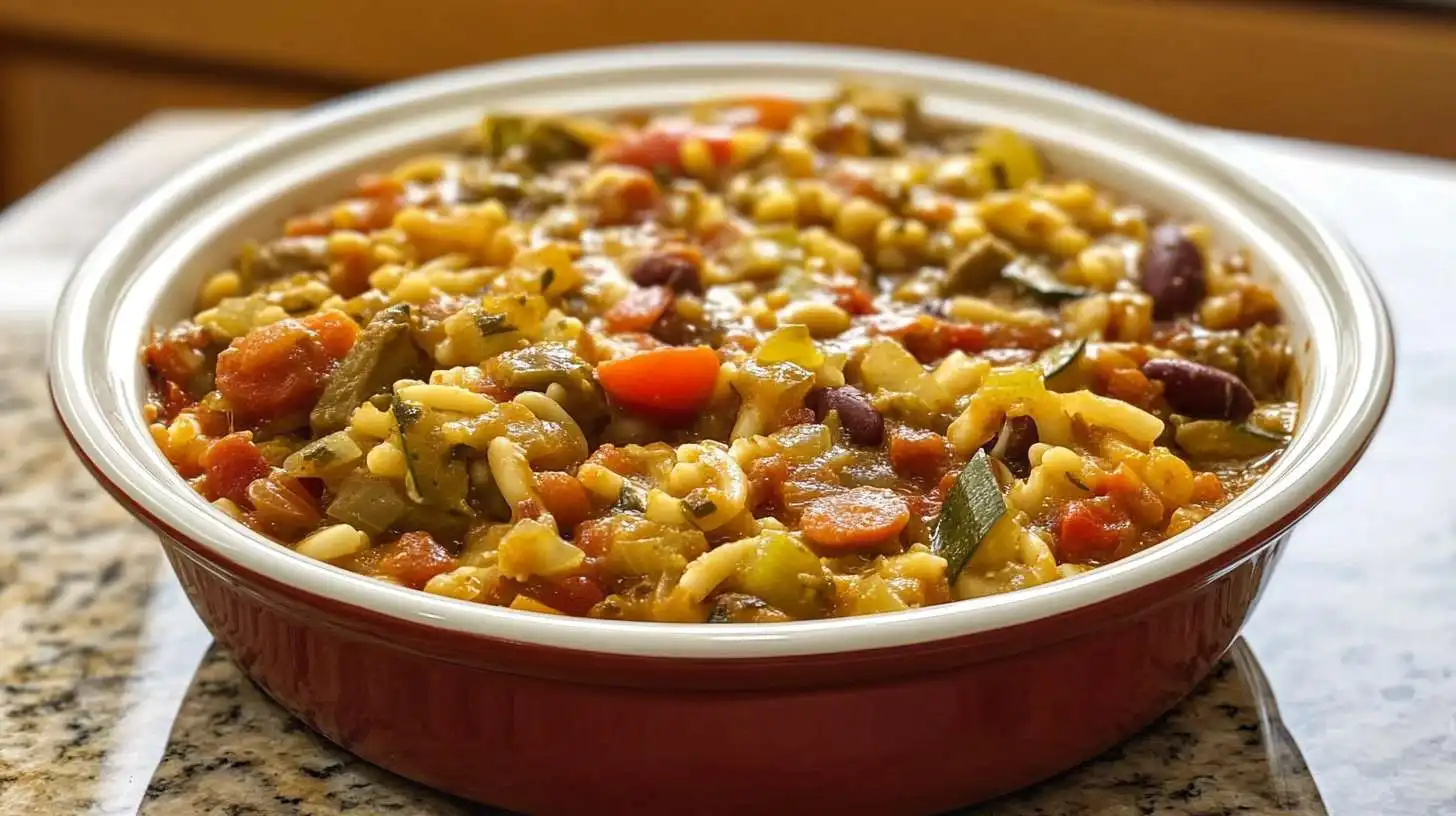If you love minestrone soup, you’re going to adore this minestrone casserole. It has all the rich, hearty flavors of the classic Italian dish but in a baked, satisfying version. This casserole is packed with vegetables, beans, pasta, and savory spices, making it the perfect one-dish meal for any night of the week.
Unlike soup, which can sometimes feel too light, this casserole is comforting and filling without being too heavy. The combination of slow-cooked tomato sauce, tender pasta, and melted cheese makes this dish a family favorite. Plus, it’s easy to prepare ahead of time, making it great for meal prepping or freezing.
In this guide, you’ll learn:
- The nutritional benefits of minestrone casserole
- The best ingredients to use for maximum flavor
- A step-by-step method to make it easy and stress-free
- Expert tips for getting the perfect consistency and taste
- Creative variations to suit different diets and preferences
By the end, you’ll have everything you need to make a homemade, restaurant-quality casserole that’s both delicious and nourishing.
Table of contents
- Why You Will Love This Minestrone Casserole
- Health Benefits of Minestrone Casserole
- Ingredients for Minestrone Casserole
- Step-by-Step Instructions to Make Minestrone Casserole
- Expert Tips for the Best Minestrone Casserole
- Variations of Minestrone Casserole
- Frequently Asked Questions (FAQ) About Minestrone Casserole
Why You Will Love This Minestrone Casserole
This minestrone casserole is more than just a simple baked dish—it’s a meal packed with flavor, texture, and nutrition. Whether you’re looking for a hearty dinner, a meal-prep option, or a vegetarian-friendly dish, this casserole is a must-try. Here are a few reasons why it deserves a place in your recipe collection.
Minestrone Casserole Has All the Flavors of Classic Minestrone Soup
Minestrone soup is known for its rich tomato base, colorful vegetables, and hearty beans, and this casserole captures all those flavors in a warm, baked dish. The pasta soaks up the savory tomato sauce, and the crispy cheese topping adds the perfect finishing touch.
A Hearty and Satisfying One-Dish Minestrone Casserole
If you’re tired of meals that leave you hungry an hour later, this minestrone casserole is the solution. With a balanced mix of carbohydrates, protein, and fiber, it’s filling without being too heavy. It’s also an excellent vegetarian option that still provides plenty of protein from beans and cheese.
Quick and Easy to Prepare
This dish is low-effort but high-reward. Everything comes together in one pan, meaning less cleanup and more time to enjoy your meal. Whether you’re cooking for a family dinner or meal-prepping for the week, this casserole is a great go-to option.
Perfect for Leftovers and Meal Prep
One of the best things about this minestrone casserole is that it tastes even better the next day. The flavors continue to develop, making leftovers just as delicious. It also stores well in the refrigerator and freezer, so you can always have a healthy meal on hand.
Health Benefits of Minestrone Casserole
This minestrone casserole isn’t just delicious—it’s packed with nutrients that make it a well-balanced and wholesome meal. The combination of vegetables, beans, whole grains, and healthy fats ensures that every bite is both satisfying and nourishing.
Loaded with Nutrient-Rich Vegetables
This dish is packed with vitamin-rich vegetables, providing essential nutrients like:
- Carrots & Tomatoes – High in vitamin A and antioxidants, which support eye health and immunity.
- Zucchini & Spinach – Great sources of fiber, iron, and magnesium, helping digestion and energy levels.
- Onions & Garlic – Packed with antioxidants and natural anti-inflammatory properties to support immune health.
Each bite delivers a colorful mix of vegetables, making it an easy way to get your daily servings of greens.
A Balanced Meal in One Dish
Minestrone casserole includes a variety of macronutrients, making it a complete meal:
- Complex Carbohydrates – Whole wheat pasta or gluten-free pasta provides sustained energy.
- Plant-Based Protein – Beans offer a rich source of protein, making this dish satisfying and muscle-supporting.
- Healthy Fats – Olive oil and cheese add good fats, essential for brain health and keeping you full longer.
This combination helps stabilize blood sugar levels and keeps hunger in check, making it a great option for any diet.
Low in Fat but High in Flavor
Unlike traditional baked pasta dishes that rely on heavy cream or butter, this minestrone casserole gets its richness from:
- Tomato-based sauce instead of creamy sauces.
- Olive oil instead of butter, keeping it heart-healthy.
- Cheese in moderation for flavor without excess fat.
This means you get big flavors without unnecessary calories, making it a great choice for weight-conscious eaters.
Ingredients for Minestrone Casserole
The key to making a flavorful minestrone casserole lies in using fresh, high-quality ingredients. This dish combines hearty vegetables, beans, pasta, and a savory tomato sauce, all baked together to create a comforting meal. Below is everything you need to prepare this easy, one-pan recipe.
Essential Ingredients
| Ingredient | Quantity | Notes |
|---|---|---|
| Small pasta (penne, shells, or macaroni) | 2 cups | Whole wheat or gluten-free options available |
| Canned diced tomatoes | 1 can (14 oz) | Fire-roasted for extra flavor |
| Tomato sauce | 1 cup | Adds depth to the casserole base |
| Vegetable broth | 2 cups | Low-sodium preferred |
| White beans or kidney beans | 1 can (14 oz) | Drained and rinsed for protein |
| Carrots | 1 cup | Diced for natural sweetness |
| Zucchini | 1 cup | Chopped for texture |
| Spinach or kale | 1 cup | Fresh or frozen, for added nutrients |
| Onion | 1 small | Diced for aromatics |
| Garlic | 3 cloves | Minced for extra flavor |
| Olive oil | 2 tablespoons | For sautéing |
| Italian seasoning | 1 teaspoon | A mix of oregano, basil, and thyme |
| Parmesan cheese | ½ cup | Optional, for a cheesy topping |
| Mozzarella cheese | ½ cup | Optional, for a melty finish |
| Breadcrumbs | ½ cup | For a crispy, golden topping |

Optional Additions for Extra Flavor
- Red pepper flakes – They provide a little spiciness.
- Mushrooms – Deepens the umami flavor.
- Sun-dried tomatoes – Boosts the richness of the sauce.
- Shredded chicken or sausage – For a protein-packed twist.
By using fresh and wholesome ingredients, this minestrone casserole remains nutritious and flavorful while being easy to prepare.
Step-by-Step Instructions to Make Minestrone Casserole
Making minestrone casserole is simple, bringing together fresh vegetables, pasta, and a flavorful sauce. Follow these steps for a hearty, comforting dish.
Cook the Pasta
Bring a big saucepan of salted water to a boil first. Cook the pasta two minutes less than the package instructions to prevent overcooking. Since the pasta will continue to cook in the oven, keeping it slightly firm helps maintain the best texture. Drain the pasta and set it aside.
Sauté the Vegetables
Heat the olive oil in a big skillet over medium heat. Add diced onions and garlic, stirring occasionally until fragrant and soft. Stir in carrots and zucchini, letting them cook for a few more minutes until they start to soften but still hold some texture.
Build the Casserole Base
Pour in the canned diced tomatoes, tomato sauce, and vegetable broth. Add Italian seasoning for flavor, followed by the white beans or kidney beans. Stir well and let the mixture simmer gently for a few minutes to allow the flavors to develop.
Assemble the Casserole
Transfer the cooked pasta to a large baking dish and pour the prepared vegetable mixture over it. Stir in the spinach or kale, making sure everything is well combined. If using, sprinkle Parmesan and mozzarella cheese evenly on top. To create a crispy, golden topping, finish with a layer of breadcrumbs.
Bake and Serve
Preheat the oven to 375°F (190°C) and bake uncovered until the top is golden and bubbly. Let the casserole rest for a few minutes before serving to allow the flavors to settle.
Garnish and Enjoy
For added flavor, garnish with fresh basil, extra Parmesan, or a drizzle of olive oil. Serve warm and enjoy this delicious, comforting minestrone casserole!
Expert Tips for the Best Minestrone Casserole
To make sure your minestrone casserole turns out flavorful, hearty, and perfectly baked, keep these expert tips in mind.
Undercook the Pasta for the Best Texture
Pasta continues cooking in the oven, so slightly undercooking it while boiling helps prevent a mushy texture. Cook it two minutes less than the package instructions to keep it firm while baking.
Use Fire-Roasted Tomatoes for More Flavor
Fire-roasted tomatoes add a deep, smoky richness to the dish, enhancing the overall flavor. If you can’t find them, regular diced tomatoes will work, but adding a pinch of smoked paprika can help mimic the depth.
Add More Protein If Desired
For extra protein, mix in shredded chicken, ground turkey, or crumbled sausage before baking. This adds heartiness while keeping the dish balanced.
Boost the Flavor with Fresh Herbs
While dried Italian seasoning works well, fresh basil, oregano, or thyme can elevate the dish. Stir fresh herbs into the casserole right before baking or sprinkle them on top before serving.
For a Crunchier Topping, Prepare the Breadcrumbs Properly
Instead of plain breadcrumbs, mix them with a drizzle of olive oil or melted butter before sprinkling them on top. This helps them brown more evenly, creating a crispy, golden topping.
Make It Creamier Without Heavy Cream
If you prefer a creamier consistency, stir in a spoonful of ricotta or cottage cheese before baking. This gives the casserole a richer texture without needing heavy cream.
Storage and Reheating Tips
Minestrone casserole stores well, making it great for leftovers or meal prep. Store in the refrigerator for up to five days in an airtight container. To avoid dryness, add a little water or broth before reheating. If freezing, store in portion-sized containers for up to three months, and thaw overnight in the refrigerator before reheating.
Variations of Minestrone Casserole
One of the best things about minestrone casserole is how adaptable it is. Whether you have dietary preferences or want to change up the flavors, there are many ways to customize this dish to suit your needs.
Vegetarian & Vegan Version
For a fully plant-based version, skip the cheese or replace it with dairy-free cheese alternatives. Nutritional yeast can also be sprinkled on top for a natural, cheesy flavor. Using vegetable broth instead of chicken broth keeps the dish completely vegetarian.
Gluten-Free Option
To make this casserole gluten-free, use gluten-free pasta instead of traditional wheat-based pasta. Substitute regular breadcrumbs with gluten-free breadcrumbs or crushed gluten-free crackers for the crispy topping.
Protein-Packed Minestrone Casserole
If you’re looking to add more protein, mix in shredded chicken, cooked ground turkey, or crumbled Italian sausage. Another option is to stir in additional white beans, chickpeas, or lentils, which provide plant-based protein while keeping the dish hearty.
Extra Creamy Version
For a creamier texture without using heavy cream, stir in a scoop of ricotta or cottage cheese before baking. This adds richness while keeping the dish balanced. A little Greek yogurt can also create a creamy consistency without adding too much fat.
Spicy Minestrone Casserole
To add some heat, mix in red pepper flakes, chopped jalapeños, or a dash of cayenne pepper to the tomato sauce. A few dashes of hot sauce before serving can also enhance the spice level for those who love bold flavors.
Low-Carb Minestrone Casserole
For a lower-carb version, swap the pasta for roasted cauliflower, zucchini noodles, or spaghetti squash. This keeps the dish hearty while reducing the carbohydrate content.
This flexibility makes minestrone casserole a great meal for different dietary needs while still being packed with flavor.

Frequently Asked Questions (FAQ) About Minestrone Casserole
What is the thickening agent for minestrone?
Minestrone naturally thickens as the starches from pasta and beans release into the sauce. However, if you want a thicker texture, you can:
- Mash some of the beans before adding them to the casserole.
- Stir in a small amount of tomato paste to enhance the sauce.
- Let the casserole rest for a few minutes after baking, as it will naturally thicken.
What does minestrone mean in Italian?
The word “minestrone” comes from the Italian verb “minestrare,” which means “to serve” or “to dish out.” It refers to a hearty, vegetable-based soup that traditionally includes beans, pasta, or rice. The casserole version captures these flavors in a baked dish.
What is the difference between minestrone and fagioli soup?
Both soups come from Italian cuisine but have key differences:
- Minestrone includes a mix of vegetables, beans, and pasta in a tomato-based broth.
- Pasta e Fagioli (meaning “pasta and beans”) focuses primarily on pasta and beans, with a thicker consistency and fewer vegetables.
Minestrone is more vegetable-forward, while fagioli soup is bean-heavy with a richer texture.
What’s the difference between minestrone and zuppa?
- Minestrone is a chunky, vegetable-filled soup that often contains pasta or beans.
- Zuppa is the general Italian word for soup, which can be smooth, creamy, or broth-based.
Minestrone is a specific type of zuppa, but not all zuppas are minestrone.
How do you make canned minestrone taste better?
If using canned minestrone soup, try these tips to enhance its flavor:
- Add fresh vegetables like zucchini, spinach, or carrots.
- Stir in extra spices like garlic powder, basil, or red pepper flakes.
- Mix in cooked pasta or beans to make it heartier.
- Drizzle with olive oil or top with grated Parmesan cheese before serving.

